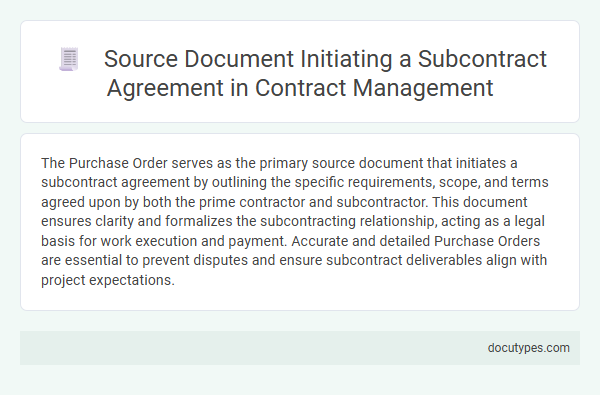The Purchase Order serves as the primary source document that initiates a subcontract agreement by outlining the specific requirements, scope, and terms agreed upon by both the prime contractor and subcontractor. This document ensures clarity and formalizes the subcontracting relationship, acting as a legal basis for work execution and payment. Accurate and detailed Purchase Orders are essential to prevent disputes and ensure subcontract deliverables align with project expectations.
Introduction to Source Documents in Subcontract Agreements
Source documents play a crucial role in initiating subcontract agreements by defining the terms and scope of work. Understanding these documents helps you ensure accurate and legally binding subcontract execution.
- Purchase Order - A formal document issued by the primary contractor to initiate the subcontract with specific work details and pricing.
- Request for Proposal (RFP) - A document inviting subcontractors to submit bids, which, once accepted, leads to the formal subcontract agreement.
- Master Agreement - A comprehensive contract outlining general terms and conditions, serving as the foundation for specific subcontract orders.
Importance of Source Documents in Contract Management
| Source Document | Description | Role in Initiating a Subcontract Agreement |
|---|---|---|
| Purchase Order (PO) | Formal document issued by the prime contractor outlining the goods or services required. | Acts as the primary authorization for subcontractors to commence work, specifying scope, deliverables, and pricing. |
| Request for Proposal (RFP) | Document inviting subcontractors to submit bids or proposals for specialized work. | Sets the foundation for subcontract agreements by defining project requirements and evaluation criteria. |
| Master Agreement | Comprehensive framework defining terms and conditions for multiple subcontracts under a larger contract. | Establishes standardized contractual terms used to initiate individual subcontract agreements efficiently. |
| Statement of Work (SOW) | Detailed description of the specific tasks, timelines, and deliverables required from the subcontractor. | Provides critical clarity in the subcontract agreement ensuring mutual understanding of project expectations. |
| Contract Amendment or Change Order | Document that modifies the original subcontract including scope, cost, or schedule changes. | Initiates revisions to the subcontract agreement to address evolving project needs or corrective actions. |
| Importance of Source Documents in Contract Management | Source documents serve as the legal and operational foundation for subcontract agreements. They ensure clear communication, accurate scope definition, and mutual accountability between prime contractors and subcontractors. Reliable source documents minimize risks such as scope creep, payment disputes, and contractual misunderstandings. They support audit trails, facilitate compliance with contractual and regulatory requirements, and enable effective project controls and performance tracking. | |
Types of Source Documents for Subcontract Initiation
Subcontract agreements are typically initiated by specific source documents that outline the scope and terms of work to be performed by the subcontractor. Identifying the correct source document ensures clear communication and legal compliance between the prime contractor and subcontractor.
Common types of source documents for subcontract initiation include Requests for Proposal (RFP), Purchase Orders (PO), and Prime Contract Statements of Work (SOW). These documents serve as the foundation for drafting and executing the subcontract agreement by detailing project requirements and deliverables.
Key Elements of an Effective Source Document
The source document that initiates a subcontract agreement typically originates from a prime contract or purchase order issued by the main contractor. This document establishes the foundation of your subcontract and outlines essential obligations and conditions.
- Clarity of Terms - Precise descriptions of scope, deliverables, and timelines ensure mutual understanding between parties.
- Legal Compliance - Inclusion of all regulatory and contractual requirements prevents disputes and enforces obligations.
- Authorization Details - Proper signatures and approval stamps validate the subcontract's legitimacy and enforceability.
Legal Requirements for Subcontract Source Documents
The source document that initiates a subcontract agreement is typically the prime contract between the main contractor and the client. This document outlines the scope of work and legal obligations that your subcontract must adhere to.
Legal requirements for subcontract source documents include clear identification of parties, detailed scope of work, and specified terms and conditions. These documents must comply with federal, state, or local regulations depending on the project location. Proper documentation ensures enforceability and protects all parties involved in the subcontract agreement.
Documentation Workflow in Subcontract Agreements
Which source document initiates a subcontract agreement in the documentation workflow? The subcontract agreement process begins with the issuance of a purchase order or a subcontract request document. This document serves as the formal trigger to establish terms, responsibilities, and scope between the primary contractor and the subcontractor.
Best Practices for Drafting Source Documents
The source document that initiates a subcontract agreement is typically the prime contract or the purchase order issued by the contractor. Best practices for drafting these documents ensure clarity, enforceability, and alignment with project requirements.
- Clear Scope of Work - Define specific tasks and deliverables to avoid ambiguities in subcontract obligations.
- Compliance Clauses - Include relevant legal and regulatory requirements to ensure the subcontract adheres to governing standards.
- Payment Terms - Specify detailed payment schedules and conditions to manage cash flow and minimize disputes effectively.
Ensuring these practices in source documents supports smooth subcontract execution and risk mitigation.
Common Challenges in Source Document Preparation
The source document that initiates a subcontract agreement is typically the purchase order or the prime contract's scope of work attachment. Common challenges in source document preparation include ensuring accuracy in contract terms, clear scope definitions, and timely approvals. Your ability to address these issues directly impacts the efficiency and compliance of the subcontract agreement process.
Role of Source Documents in Risk Mitigation
Source documents such as purchase orders or master contracts typically initiate a subcontract agreement. These documents establish clear expectations and terms between the primary contractor and subcontractor.
Accurate source documents play a crucial role in risk mitigation by defining scope, deliverables, and payment conditions. Proper documentation reduces disputes and enhances accountability throughout the subcontracting process.
Which Source Document Initiates a Subcontract Agreement? Infographic

